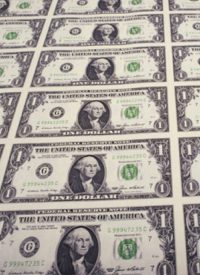
When Anthony Mason, CBS News’ senior business correspondent, visited the Treasury Room, he called it the location of “essentially the American credit card machine.” It’s where traders buy and sell United States’ treasury bills, notes, and bonds in order to finance government operations. Mason’s revelation was profound: "I found that room kind of spooky. If we can’t [sell] those IOUs — which keep the government running on a day-to-day basis — then we can’t run the country anymore. We [won’t] have the money."
CBS then went on to review the repetitive and increasingly tiresome litany of disasters that await if those IOUs can’t be sold.
The government will take in $2.3 trillion in revenues this year but is spending $3.6 trillion, leaving a chasm of debt that has to be papered over through the operations of the Treasury Room. Fifty-five percent of the spending is mandatory: Social Security, Medicare, military, etc. And CBS had the inevitable chart showing lots of red ink. CBS explains, redundantly, that it’s only by the grace of foreign governments that the country is able to function at all. China and Japan hold huge amounts of those IOUs, and they’re getting restless. And then, the kicker: This can’t go on forever! Something must be done!
To add emphasis to this dreary, continuing, and much-less-than-forthright litany of debt problems with which nearly every American citizen who can read is all too familiar, MoneyWatch provided additional night-time reading with its “18 Scary US Debt Facts,” which included the following:
– When World War II ended, the national debt was 122 percent of the GDP. Following the war years it dropped to 38 percent. Today it’s pushing 100 percent;
– In the last 11 years, the national debt has more than doubled;
– The debt rises almost $4 billion every day;
– The government borrows $5 billion every day;
– Total liabilities of the government exceed $65 trillion;
– The debt ceiling of $14.2 trillion will be reached in May, 2011, if not sooner;
– The government has to borrow 41 cents of every dollar it spends;
– And etc.
The reasons why citizens should be concerned about all of this is also provided courtesy of CBS:
1. The debt is growing larger than the economy, and the economy will never catch up;
2. Once the federal debt exceeds 90 percent of GDP, it’s game over;
3. Those who buy those IOUs will want higher interest rates to offset the risk of default;
4. And kicking the can down the road won’t work: there is no more road.
And the inevitable solution? Raising taxes. The Bipartisan Policy Center (BPC) is calling for (surprise!) a “national consumption” tax of 6.5 percent.
To come to this inevitable conclusion, several points have been consistently overlooked in their “analyses” of the problem. First, these debts have been growing in nearly a straight line upwards since 1971 when President Nixon “closed the gold window” and allowed a pure fiat paper money, the dollar, to become the world’s reserve currency. Second, both political parties have had a hand in creating the increasingly lucrative trough out of which they have been rewarding their political cronies and bankers. Third, attempts in the past to reduce government as promised by Goldwater, Nixon, Carter, Reagan, Bush I and II, Clinton, and Obama have successfully either been drowned in infancy or thwarted deliberately as any such efforts began to gain momentum.
Finally, the solution has been at hand all along. The only way any administration can consistently spend more than it takes in, despite growing resistance from its citizens, is through the Treasury Room, the location of the great American credit card machine. And to whom is an increasing amount of those IOUs being sold? The Federal Reserve.
Cutting taxes by cutting programs will not be sufficient, even if they are proposed by such a worthy as Henry Hazlitt, who wrote back in 1978: “To avoid irreparable damage, the budget must be balanced at the earliest possible moment, and not in some sweet by-and-by. Balance must be brought about by slashing reckless spending, and not be increasing a tax burden that is already undermining incentives and production.”
Lew Rockwell and others have said that the real problem is philosophical. CBS News’ Washington correspondent Bob Schieffer was as close as any in the media have dared to come: “You have to start thinking about cutting programs. It’s going to take an overall refocusing on what we want from government and what we expect from government.” But even that isn’t enough.
Cutting spending and enforcing constitutional limitations are going to be the final solutions to runaway spending. But that won’t happen until the average citizen gets past what Russel Long, former Chairman of the Senate Finance Committee, said was everybody’s view of taxes: “Don’t tax him, don’t tax me, tax that fellow behind the tree.” The funding mechanism — those IOUs being sold by the Treasury to the Federal Reserve who buys them with money conjured out of the ether — to spend money the government could not raise directly, must be shut down. And that is what is going to take real courage, commitment, strength of character, and just plain old-fashioned gumption. Anything less misses the point.



